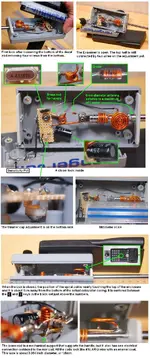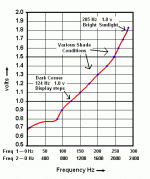This thread seems to have only a few field reports from users of the Examiner, and a lot of opinions.
If you are interested in facts from a user of the Rangertell Examiner, I have tested two of the current models which are offered for sale today.
Here are some facts and details:
The Rangertell Examiner is offered at a special sale price of $599 USD for the "
T-G Ver 8.08B" model. This is the basic Examiner, which comes with a no-name Chinese calculator attached, and a CD which has PDF files showing instructions and lists of keys to press which are claimed to produce the necessary frequencies for finding various buried things.
Rangertell also offers the $899 USD "
deluxe" model at their special sale price. This is the same basic Examiner, but with a TI solar powered calculator attached, and has a single ground probe included which you can connect to your laptop computer to send an audio tone to the probe between 0 and 20,000 Hz. The CD includes instructions, and more calculator key codes than are given in the basic model, and also has an audio tone software that you can use on your laptop.
Rangertell also offers a new $899 USD "
Deluxe Unity XII" model (new for 2012) at their special sale price. Rangertell advertising says with this model You get the same features as with the Deluxe; the Ground Probe, software but 200 frequencies. I also see where they say it also has a rear 'bait' sample chamber with switch to choose between Examiner and sample chamber.
I am looking for any information about the Ranger Tell Examiner I can find. How it works? What have you found with it that you want to share about? Ease of use? If my brain is dowsing does it affect it? Any other answers about it would help.
Thanks
I have a deluxe Examiner.
I tested both the "T-G 808b" standard model, and the "deluxe" model. I performed extended tests in the field, as well as tests in the lab to measure what signals this LRL was sending. The field tests results convinced me that I can agree with Carl and woof!. I witnessed detection which appeared exactly the same as the detection you will find when dowsing. After sending emails to the Rangertell representative, he told me the Examiner does not use dowsing, and it should work as soon as you turn it on. This convinced me I must be one of those people who cannot locate things on my own, using the Examiner. So I recruited more than 50 volunteers to test to see if they could locate anything with these two Rangertlell Models. (Note: these volunteers included some who tested the T-G model and some who tested the deluxe model). Nobody was able to locate anything so far. It was impossible to conduct any scientific test to establish the percentage of detection that was found with the Rangertell TG or Deluxe model, because nobody was able to locate anything to establish a base line.
So is the Examiner TG different from the regular Examiner model? What factors make the pinpointing hard to do?
The T-G model and the Deluxe model are identical in construction, except the deluxe model has a TI solar powered calculator rather than a no-name Chinese calculator. The physical differences are the TI calculator does not turn itself off after a few minutes of running, and it uses less power, and operates at a different clock frequency than the stronger no-name calculator. The other difference, is the deluxe model has more frequencies included in the CD, so you have more factory-approved numbers you can enter into the calculator. I have observed no difference in pinpointing between the two models. I saw no locating or pinpointing of anything. Both of these locators seemed equally influenced by the force of the wind and gravity, and by using your hand muscles to cause them to turn. They seem to have very low friction in the plastic-to-brass bearing surfaces. The other models which I am reading about here are older versions of the Examiner which are no longer made.

The vast majority of LRLs are just dowsing rods. The electronics are added to make you feel good about spending a ton of money on a dowsing rod.
I had that same thought. But I was interested to know for certain, rather than to use common sense. I remembered years ago listening to calculator switching sounds by placing a small iron core coil above a calculator keyboard and hearing the internal clocking signals on the speakers from an audio amplifier. I wondered what signals exactly this calculator was sending to the Examiner, and what did the circuitry inside the Examiner do to this signal? So I spent a lot of time measuring what came out of the calculator, and how it interacted with the electronics inside the Examiner. But this time I did the measuring with real electronic lab instruments, instead of an audio amplifier. As it turned out, the calculator sends out an electric signal which can be detected on sensitive instruments which are properly grounded at a distance of approximately 6 inches, before they become lost in the other electric noise in the air. However, there is no inductive coupling, as claimed by the manufacturer. This was proven by shorting the Examiner pickup coil and also wrapping aluminum foil over it. The signal entering into the Examiner circuitry was unchanged. But what happened to the signal after it entered into the Examiner circuitry? It was attenuated to the point that it was non-existent, below the noise floor when I was probing in the vicinity of the antenna, and other conductive parts of the Examiner circuit. The only place where I could detect any signal at all when the Examiner was fully assembled was when probing the air around the calculator itself. The calculator clocking signal did not pass through the Examiner handle or antenna in any measurable amount. My guess is the size of that antenna was picking up too much noise from the air, and drowning out any trace of the calculator signal which might have been capacitively coupled to the innards. And it does not surprise me, when looking at the circuit diagram. Those capacitors and diode don't help a signal to pass through. After later examination of the circuitry, I came to the conclusion that it is non-functional, and will give the same results if you remove it all, including the calculator, and leave only the antenna to provide balancing of the unit.
If the keyboard breaks, will any old calculator work in its place?
If the internal clock frequency shifts, will the thing keep "working" the same as always anyhow?
--Dave J.
This is a good question. I think woof! knows the right answer. But I checked this out thoroughly to find the answer by testing. What the measurements show is it does not matter what sequence of keys you push, After you release your final keystroke, the calculator will send out a fixed frequency signal for a few inches that is not related to keystrokes you made. These are the clocking cycles for the calculator which are fixed by the capacitor and resistor values of an internal oscillator. The strongest signal is near the display, from the display drivers. But the signal which the Examiner "pickup coil" is positioned at is the keypad strobing clock signal. This is an audio signal which does not change.
Now, we know the T-G model and deluxe model both use the same exact hardware, except different calculators. As it turns out, these two calculators have two different clock frequencies. I found the no-name Chinese calculator has a stronger signal, which seems understandable, because it runs on 3 volts from two batteries rather than 1.5+ volts from a solar cell and a capacitor for backup storage.
But it get's worse... Suppose you want to get the very best of precision frequencies, so you order the deluxe model, and you type in the prescribed calculator codes to get some exact frequency. What you don't know is the frequency you entered in the calculator is not the frequency the calculator is sending out. Only the oscillator clocked frequency is coming out of the calculator. But the frequency for the TI solar calculator clock is dependent on the voltage at it's power supply. Not a little bit dependent, but a lot. This means that when you move your deluxe Examiner from bright sunlight to a shaded area, the frequency can drop to less than 1/3 of frequency it was sending when it was in the bright sun. This same voltage-related frequency drift can also be seen on the other Chinese calculator if the battery voltage drops over time. See the chart below which shows the frequency drift I recorded and plotted against voltage, and various light conditions.

This chart was made from actual measurements I made from the Rangertell TI Solar calculator clocking signal which the "pickup coil" is exposed to, in various lighting conditions we find when hunting for treasure. You can see the frequency drops to 1/3 when you walk from bright sunlight to a dark shaded area.
Some facts about the Examiner calculators:
1. Neither of these Examiner calculators changes their frequency or anything about the signals they emit after you take your fingers off the keypad.
Their signal is always the same, unless you change to a different calculator.
2. The no-name Chinese calculator frequency at the "pickup coil" is 576 Hz in a 30 Hz envelope frequency.
3. The TI Solar calculator frequency at the "pickup coil" is 2240 Hz in a 280 Hz envelope frequency.
(This frequency can drop to 1/3 this amount when the light shining on the solar cell becomes dim).
4. The oscillator frequencies for both calculators are slightly temperature dependent. I observed them change about 5% when the temperature changed 100 degrees F.
After observing the field tests and the lab tests, I am beginning to wonder if this may indeed be a scam LRL, as Carl-NC and woof! seem to think. But since I hear a few reports of how well it works, I know there must be some principle operation which causes pressing those calculator keys to change frequencies and discriminate various buried things. It certainly is not an electronic principle, from the evidence I have witnessed in the testing. The only conclusion I reached from my observations so far is the Examiner appears to work as well as dowsing works.
Up to this point, I have seen only a little more than 50 people test these Examiners in the field. However, if there is someone who wants to try it before he buys, they are welcome to try the factory-new deluxe Examiner I have. I have the CD with all the precision codes, and I will meet you anywhere in Southern California that you want to try the deluxe Examiner. Maybe it will work for you. If it does, then you can send for your own Examiner, and become the next happy Examiner user. But if it doesn't, then you can save yourself enough money to get some nice Christmas presents for the family.
Best Wishes,
J_P





